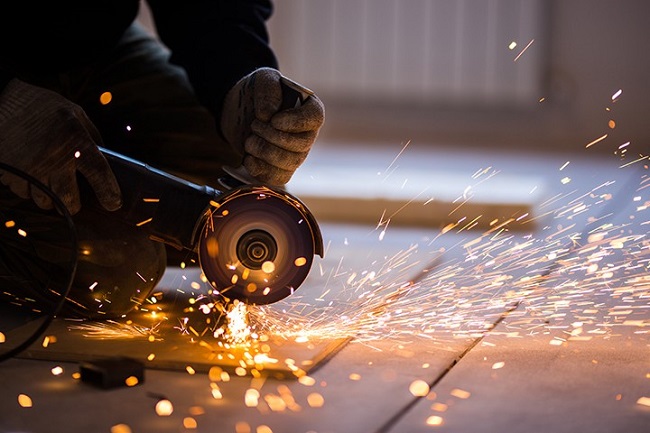The most important distinction between tools is the one based on their power source. The basic household tools (screwdriver, wrench, hammer, clamp, handsaw) are hand powered. Slightly more intensive projects require tools powered by electricity, such as drills, grinders and circular saws. Industry or trade specific tools can use pneumatic, liquid fuel, hydraulic, and powder-actuation. Bulky or power intensive tools (like a table saw and demolition hammer) are stationary and need access to electrical power with a cord. Smaller tools are easier to manoeuvre with in tight spaces. They are cordless, are usually powered by a battery and come with a charger. Here’s a bit more info regarding the different types of tools, some buying, maintenance and safety tips.

Hand tools
Shopping
There are certain hand tools that are equally useful for carpentry, electrical or construction work. If you are starting from scratch, our first tip would be to look for multi-functional tools. Instead of buying the first wrench you come across, go for an adjustable one that will serve you a for a range of purposes. Your best bet is to buy versatile tools: all purpose hammer, pliers, vise, utility knife. When buying electrical tools stick with those with an onboard voltage tester.
The widespread use of the internet brought about an increase in trading used tools on a scale that’s never been seen before. Shopping hand tools from someone you’ll never hear from again raises so many red flags. Do not waste your money cruising pawnshops, flea markets, thrift stores and garage sales to buy used tools on a bargain. Not unless you take someone well versed in the trade with you. Inspecting used tool and estimating their worth is not an easy task.

Everyone needs a reliable basic hand toolbox in their home. Invest in a new versatile set from a licensed local dealer to save yourself headaches and have peace of mind. Do not try to save on buying cheap hardware either. Your nails, screws and all those minuscule pieces can make or break your project. Go for quality hardware as this is usually overlooked.
Maintenance
It’s a well known fact that proper storage and maintenance can extend the life of a tool. The space you have on your hands will dictate the type of storage you use. You can go for pegboards, a chest, shelves, drawers, or multiple boxes and bags – it does not matter as long everything has its place. Practical wisdom is to clean each tool after use and keep it dry. Examine them for damage before storing them away.
Safety
Many of the injuries involving hand tools happen among people who are overconfident. Here are some of the main hazards to look out for:
– loose handles on a hand tool (hammer or axe) may allow the head to fly off the top and hurt the user
– wrenches with sprung jaws might slip from your hands
– impact tools (wedge or chisel) can shatter their head and project sharp fragments toward the user
– the tip of a tool can break and fly off, hitting the user or someone else close by
Power tools
Shopping
When shopping for power tools it is best to stick to established brands. Buying a DeWalt, Makita or a Milwaukee tool is your safest bet. This will give you confidence in the value the tool provides for the money. It will also make it easier for you to find instructions and advice from more experienced users if you are a beginner. Once you have found a brand that you truly like and is within your budget range, stick to it. Do not forget to consider the compatibility of the batteries, and any add-ons you might need, if you go for different brands. I have found the Milwaukee tool range to be one of the most versatile ones on the market that provide great value for money.

Maintenance
Cleaning power tools can be tricky. First, you have to double check that you have unplugged them before you begin with the cleaning process. Get the dust off the tool, wipe its surface and lubricate the moving parts. This part is more tool-specific compared to hand tools, so when in doubt – check the user manual that came with the tool. Your safest bet is storing the tool in its original case. Power tools usually come with hard plastic cases that protect them from humidity.

Safety
Numerous factors affect the risks associated with using power tools. The main ones are corrosion and rust, cracked housing and lazy engine. Fixing these issues is best done by a professional who works at an authorised service centre.
This safety checklist can greatly reduce the risk of injury:
- Power tools must have guards and safety switches
- Do not carry the tool by the cord
- Disconnecting the tool from the receptacle should not be done by yanking the cord
- Keep cords away from sharp edges, heat and oil
- Unplug the power tool when changing any add-ons (blades and cutters) and before servicing or cleaning it
- Power tools must have guards and safety switches in place
- Work the tool with both hands and secure the element you work on with clamps
- Keep your fingers away from the switch button while carrying the tool


